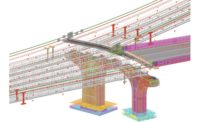Building Information Modeling Boosters Are Crossing That Bridge
Virtual design and construction tools are crossing over from buildings to transportation projects. Officials admit that 3D parametric modeling in the transportation sector has trailed the buildings sector, but they say change is afoot. “In 10 years, we will be living in a BIM world,” predicts Cosima Crawford, chief engineer for the New York City Transit Authority. “It’s our new reality,” she says.That reality has transportation teams tackling the same challenges their building counterparts are seeing in their transition to building information modeling. These include BIM technology issues, process change and institutional buy-in.


A few years ago, NYCTA’s parent agency, the Metropolitan Transportation Authority, began to use VDC, in which a project is built virtually in the computer using “intelligent” 3D software packages, for megaprojects, such as the $1-billion Fulton Street Transit Center and the $4.451-billion Phase One Second Avenue Subway project. VDC approaches help develop work phasing, passenger flows and placement of columns and piles. Visualizations “give [local businesses] an understanding of the construction process early on,” says says MTA’s William Goodrich, program executive for the Second Avenue Subway project.
“Time sequence is critical for any project that expands beyond one property area,” says Rachel Arulraj, director of the Virtual Design and Construction Geotech & Tunneling Technical Excellence Center with the Second Avenue project’s owners’ consultant construction manager, Parsons Brinckerhoff, New York City. On that job, a contractor’s Primavera scheduling software links to a single, shared database, which is used to analyze sequences and component interface issues. The model only is only detailed as needed, she adds. “VDC is not [just] a fancy tool—it’s an approach.”
BIM is also starting to infiltrate cost estimating. Eventually, “we’ll need to understand and link to as-built BIMs that will ‘talk’ to the maintenance staff,” says Judith Kunoff, NYCTA’s chief architect.
It’s not just in-house staff that will need to be BIM literate. “We’re now demanding it of our consultants,” says Kunoff.
Contractors are already onboard. “The more successful contractors expect it,” says Bob Dennison, chief engineer with the New York State Dept. of Transportation. “Once, we put out a project that didn’t have it, and they were disappointed.” Dennison says about 50% of all NYSDOT projects come with a BIM option. “We Webcast our bid openings. I can see a day when you receive your plans electronically, prepare and submit them electronically, and watch the process on your computer.”
NYCTA is about to take a big step in that direction. On Oct. 1, the agency, which uses software from vendor Bentley Systems Inc., Exton, Pa., will start all new projects using Bentley’s V8i platform, released last December, to create bi-directional data flow among project collaborators. The move is expected to solve BIM’s plagues: lack of interoperability and compatibility.
Jerry Zogg, a Wisconsin DOT roadway standards engineer, says contractors like using a VDC grading tool for automated machine guidance (AMG), which prompted research with the University of Wisconsin. The pilot program to grade projects using BIM, based on 2D documents given to contractors, resulted in higher-quality construction that was faster and less costly, he says. The end result is a statewide specification that gives grading contractors an AMG option.
WisDOT plans to develop a spec for roadway base courses and, then, paving. “From a design perspective, we have to take a look at hardware requirements and information technology capabilities,” says Zogg. “The industry is champing at the bit for us to move ahead more quickly.”
Not everyone has jumped on the BIM bandwagon. Some engineers think BIM is overkill for simple bridge jobs. Restructuring entrenched systems and cultures are also issues. For California Dept. of Transportation divisions, a bridge Website for submittals is “kind of archaic,” says Doug Dunrud, Caltrans’ chief bridge design engineer. Each division has its own server. “You take a bunch of papers and move them from one location to another,” he says. “Instead of sharing information, you’re handing over a baton.”
Nevertheless, Caltrans is gaining BIM speed. As far back as 1997, the department had asked PB to create 4D models, which also include job-task sequencing over time, and simulations for projects related to the Oakland-San Francisco Bay Bridge. But a more recent project, called Doyle Drive, to replace the south access road to San Francisco’s Golden Gate Bridge is the first state project using BIM as both a design development and...







